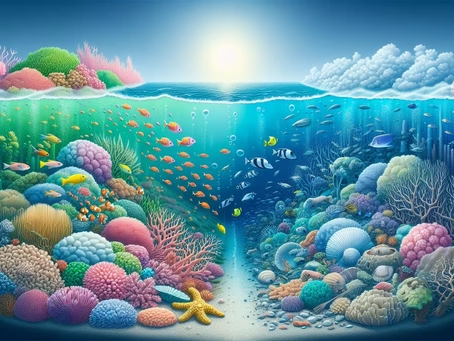Understanding Ocean Acidification
Ocean acidification is a gradual decrease in the ocean’s pH, driven mainly by the absorption of carbon dioxide (CO2) from the atmosphere. While it often receives less attention than climate change, it poses equally significant risks. This shift in ocean chemistry disrupts marine ecosystems, undermines human livelihoods, and threatens biodiversity worldwide. To protect both the ocean and ourselves, it is critical to understand the science, consequences, and solutions tied to this issue.
The Science Behind Ocean Acidification
Breaking Down the Chemistry
When atmospheric CO2 dissolves in seawater, it forms carbonic acid, which releases hydrogen ions that increase acidity. The pH of seawater is naturally slightly basic, but rising CO2 levels are pushing it downward at an unprecedented pace. Organisms that depend on calcium carbonate, such as corals, shellfish, and some plankton, face increasing difficulty building and maintaining their structures. Since these species sit at the foundation of marine food webs, their decline threatens entire ecosystems.
Main Drivers
- Burning of fossil fuels increases atmospheric CO2.
- Deforestation reduces natural carbon absorption capacity.
- Agricultural runoff contributes excess nutrients to marine waters.
The Impact on Marine Life
Calcifying Organisms
Shellfish, oysters, and corals struggle to form strong shells or skeletons in acidic waters. Weaker structures reduce survival rates and disrupt reef habitats, which support countless other marine species. These ripple effects jeopardize fisheries and coastal economies reliant on healthy ecosystems.
Fish Populations
Fish are not immune. Acidification affects their sensory systems, altering behavior and survival instincts. Changes in growth, reproduction, and larval development reduce population stability. This can destabilize predator-prey relationships and threaten food security worldwide.
Coral Reefs at Risk
Often called the rainforests of the sea, coral reefs are among the hardest hit. As acidity rises, coral skeletons dissolve, threatening reef survival. The loss of coral ecosystems affects marine biodiversity, coastal protection, and industries like fishing and tourism.
Human and Economic Consequences
Fisheries Under Pressure
- Declining shellfish populations reduce global seafood supplies.
- Disrupted food chains impact valuable fish stocks.
- Reduced catches put fishing communities at risk.
Coastal Communities
Coastal livelihoods are threatened as tourism declines and reef systems weaken. Ocean acidification compounds risks from storm surges and erosion, placing added pressure on vulnerable communities.
Economic Costs
The fallout includes higher seafood prices, loss of tourism revenue, and costly investments in coastal protection. These economic ripples illustrate that acidification is not just an environmental problem but a global financial challenge.
Global and Local Solutions
International Collaboration
Initiatives such as the United Nations programs and the Global Ocean Acidification Observing Network (GOA-ON) emphasize cross-border cooperation. Shared research and policy coordination are essential for tackling this worldwide challenge.
Policy and Innovation
- Legislation to cut carbon emissions at industrial levels.
- Investment in renewable energy to reduce fossil fuel reliance.
- Support for carbon capture and storage technologies.
Community and Individual Action
Individual choices also matter. Reducing personal carbon footprints, supporting sustainable seafood, and engaging in local conservation efforts all contribute to healthier oceans. Citizen science programs further empower people to help collect data and raise awareness.
Looking Ahead
Marine Adaptations
Some species display resilience by altering behavior, adjusting body chemistry, or shifting habitats. While promising, these adaptations cannot replace the urgent need to reduce CO2 emissions.
Preparing for Change
Communities and industries are experimenting with adaptive strategies, from more sustainable fishing practices to aquaculture innovations. Strengthening coastal defenses and diversifying local economies are also part of preparation efforts.
Conclusion
Ocean acidification is a silent crisis with far-reaching consequences for marine life, human communities, and global economies. The solutions demand collective effort—governments, scientists, communities, and individuals all have a role to play. By investing in renewable energy, enacting effective policies, and promoting sustainable practices, humanity can slow the pace of ocean acidification and safeguard the health of our blue planet for generations to come.

